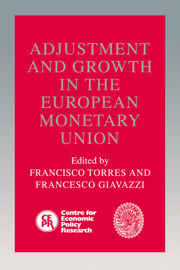Book contents
- Frontmatter
- Contents
- List of figures
- List of tables
- Preface
- List of contributors
- Foreword
- 1 Introduction
- 2 Economic and monetary union: critical notes on the Maastricht Treaty revisions
- Discussion
- 3 The design of optimal fiscal rules for Europe after 1992
- Discussion
- 4 Contracts, credibility and common knowledge: their influence on inflation convergence
- Discussion
- 5 Inflation in fixed exchange regimes: the recent Portuguese experience
- Discussion
- 6 Models of economic integration and localized growth
- Discussion
- 7 Shocking aspects of European monetary integration
- Discussion
- 8 Lessons of Massachusetts for EMU
- Discussion
- 9 Financial and currency integration in the European monetary system: the statistical record
- Discussion
- 10 Currency substitution: from the policy questions to the theory and back
- Discussion
- 11 Coordination of capital income taxes in the economic and monetary union: what needs to be done?
- Discussion
- Index
Discussion
Published online by Cambridge University Press: 29 January 2010
- Frontmatter
- Contents
- List of figures
- List of tables
- Preface
- List of contributors
- Foreword
- 1 Introduction
- 2 Economic and monetary union: critical notes on the Maastricht Treaty revisions
- Discussion
- 3 The design of optimal fiscal rules for Europe after 1992
- Discussion
- 4 Contracts, credibility and common knowledge: their influence on inflation convergence
- Discussion
- 5 Inflation in fixed exchange regimes: the recent Portuguese experience
- Discussion
- 6 Models of economic integration and localized growth
- Discussion
- 7 Shocking aspects of European monetary integration
- Discussion
- 8 Lessons of Massachusetts for EMU
- Discussion
- 9 Financial and currency integration in the European monetary system: the statistical record
- Discussion
- 10 Currency substitution: from the policy questions to the theory and back
- Discussion
- 11 Coordination of capital income taxes in the economic and monetary union: what needs to be done?
- Discussion
- Index
Summary
This is a very interesting chapter. In just a few equations Giuseppe Bertola manages to summarize much of the literature on endogenous growth and extend it to a two-country framework. This by itself is enough to make the chapter rewarding to study carefully.
The purpose of the chapter is to consider how the move from autarky to capital and labour mobility affects the location of activities. The motivation is ‘1992’ which Giuseppe Bertola takes seriously. Many observers believe that, in fact, ‘1992’ is just the last relatively limited step in the completion of the Treaty of Rome. There has in essence been a free market in goods, capital and labour for some time although some barriers to capital mobility remained until the dismantling of capital controls on 1 July 1990 and there is still room for greater mobility among the most skilled jobs, such as lawyers, medical doctors and university professors. It might have been more fruitful if Bertola had applied his ideas to the southern European countries which joined the European Community in the mid-1980s. This observation might take a bit of glamour off the dramatic conclusions that he reaches, for we know that nothing so dramatic as he envisages has occurred among the older core of EC countries. The true drama is the European Monetary Union, a logical implication of capital mobility-cumfixed exchange rates (Wyplosz (1986)).
- Type
- Chapter
- Information
- Adjustment and Growth in the European Monetary Union , pp. 189 - 192Publisher: Cambridge University PressPrint publication year: 1993



